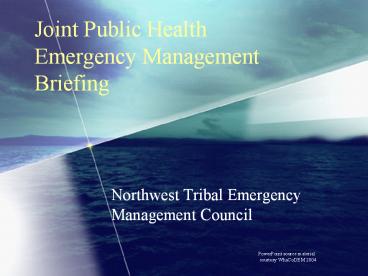Joint Public Health Emergency Management Briefing - PowerPoint PPT Presentation
Title:
Joint Public Health Emergency Management Briefing
Description:
Title: Welcome Author: Tulalip Police Last modified by: Tulalip Police Created Date: 10/4/2005 4:46:51 PM Document presentation format: On-screen Show – PowerPoint PPT presentation
Number of Views:332
Avg rating:3.0/5.0
Title: Joint Public Health Emergency Management Briefing
1
Joint Public HealthEmergency Management Briefing
- Northwest Tribal Emergency Management Council
PowerPoint source material courtesy WhaCoDEM 2004
2
NW Tribal Emergency Management Council
Who are we and what do we do?
3
NW Tribal Emergency Management Council (NWTEMC)
- A consortium of 8 Tribes in Northwest Washington
to address Emergency Management and Homeland
Security issues faced by those tribes.
4
NW Tribal Emergency Management Council (NWTEMC)
Participating Tribes
- Stillaguamish
- Swinomish
- Tulalip
- Upper Skagit
- Lummi
- Nooksack
- Samish
- Sauk-Suiattle
Several tribes across state expressing interest
5
NW Tribal Emergency Management Council (NWTEMC)
- Partners
- Washington State Homeland Security Region 1
- Island
- San Juan
- Skagit
- Snohomish
- ESCA
- Everett
- Whatcom
6
NW Tribal Emergency Management Council (NWTEMC)
- Partners
- Washington State
- DOH
- EMD
- DOE
- WSP
- Federal
- FEMA Region X
7
NWTEMC Staffing
- Lynda Harvey, Emergency Management
- Homeland Security Region 1 Representative
Tulalip Tribe - Office of Neighborhoods
- Tribal County Blockwatch Program
- 20,000 participants
- Former Clinic Director
8
NWTEMC Staffing
- Curt Russell, Homeland Security
- Tribal Representative to State Emergency Response
Commission (SERC) - Homeland Security Region 1 Representative Lummi
- Retired Paramedic 10-years
- State Tribal Hazmat Conference Planning
9
NWTEMC Staffing
- Lorelei Ranney
- Planner Tulalip Tribe
- Cheryl Johnson
- Safety Office - Lummi
10
What Do We Do?
- We develop maintain the systems needed to
ensure your success during times of crisis. - We will assist in your development of Emergency
Management Plans - We will assist with Homeland Security issues
11
What Do We Do?
- We educate our citizens
- We train our responders
- We help develop emergency response plans
- We build teams
- We can provide a bridge
12
What Do We Do?
- We are your link to regional, state, and federal
Homeland Security programs - We are a link for access to resources to enhance
and supplement your EM and Homeland Security
programs - Federal
- State
- Regional
- Local
13
Organization
- Governing Board
- Charter
- By-laws
- Tribal Governments
- Regional oversight HLS Region 1
- State Grant reporting requirements
- Federal
14
OrganizationInterlocal Cooperative Agreement
Future and ongoing goal
- Participating Tribes
- Surrounding Jurisdictions
15
OrganizationInterlocal Cooperative Agreement
- Fulfills state mandate for emergency management
organization - State law
- Spells out roles and responsibilities
- Provides for mutual aid
- Can define budget contributions
16
NWTEMC Services
- Assist at Tribal and/or County EOC
- Review and/or assist develop Comprehensive Plan
- Provide planning assistance
- Maintain Operating Guidelines
- Maintain essential databases
- Volunteers, resources, shelters, etc.
17
NWTEMC Services
- Can provide on-scene response coordination
- Act as Local On-Scene Coordinator in unified
command as appropriate - Provide responder training information
- Facilitate TERC/LEPC to maintain compliance with
the Emergency Planning Community Right-to-Know
Act
18
Tribal Public Health Emergency Preparedness
- Provide forum for Region 1 Tribal Clinics to
develop Public Health Emergency Management plans - Coordinate initial efforts for emergency planning
among regional Public Health partners - Tribes
- State
- Region
- County
19
Tribal Public Health Emergency Preparedness
- PH issues such as
- Quarantine
- Isolation
- Jurisdiction
- Tribal PH law or codes
- Training
- Public education
20
Tribal Public Health Emergency Preparedness
- This effort to plan and prepare the tribal
clinics that serve their respective communities
is just getting started in a coordinated effort.
The current plan is tribes in Homeland Security
Region 1 will work to together to share
resources, knowledge, and skills to develop
comprehensive public emergency planning
documents, address public health jurisdiction
issues, and provide a network of expertise.
21
Tribal Public Health Emergency Preparedness
- Initial meetings are scheduled in 2005 with
Lummi, Nooksack, Tulalip, Upper Skagit, and other
tribes invited to participate in planning
meetings. Washington State Dept of Health as well
as county regional heath departments are
invited to attend as well.
22
SARA Title III / EPCRA
- Requires Community Hazmat Planning
- Cross Border Plan
- Emergency Release Notifications
- On Going Release Information
- Community Right-to- Know Act
23
Strategic Liaisons
Private Sector
Public Sector
Volunteers
Tribal Govt. CEOs Law Enforcement Fire Public
Works 9-1-1 Dispatch Schools Animal
Control Special Districts Regional Govts. State
Govt. Federal Govt.
Media Industry Business Utilities Railroad Airline
s Hospital Clean Sound Coop Contract Weather
SAR Red Cross Salvation Army PIOs Sandbaggers Spe
c. Volunteers SET Teams CISD Teams LEPC CERT Teams
24
Natural HazardsHazard Risk
Vulnerability
- Flood High Moderate
- Earthquake Mod/High High
- Mudflow/Landslide High Moderate
- Severe Weather High High
- Forest Fire Moderate Low/Mod
- Tidal Overflow Moderate Low
- Tsunami Low Low
- Tornado/Funnel Cloud Low Low
- Epidemic Low Mod/High
- Volcanic Eruption Low Mod/High
25
Technological Hazards Hazard Risk Vul
nerability
- Hazardous Materials High Mod/High
- Fire/Explosion High Low/Mod
- Transportation Accident Mod/High Mod/High
- Utility Failure High High
- Domestic Disturbance Moderate Moderate
- Terrorism Low/Mod Mod/High
- Resource Shortages Low Moderate
- Dam Failure Low Moderate
- Radiological Accident Low Low
26
Incident Escalation
27
(No Transcript)
28
Questions?
www.nwtemc.org
Lynda Harvey 360.658.2904 lyndaharvey_at_nwtemc.org































